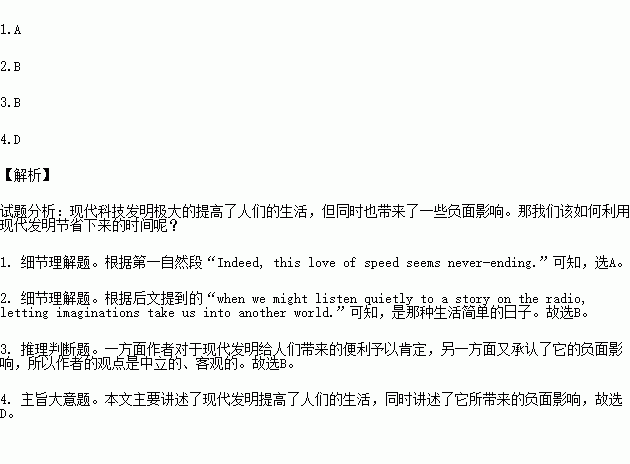题目内容
Modern inventions have speeded up people’s loves amazingly. Motor-cars cover a hundred miles in little more than an hour, aircraft cross the world inside a day, while computers operate at lightning speed. Indeed, this love of speed seems never-ending. Every year motor-cars are produced which go even faster and each new computer boats (吹嘘) of saving precious seconds in handling tasks.
All this saves time, but at a price. When we lose or gain half a day in speeding across the world in an airplane, our bodies tell us so. We get the uncomfortable feeling known as jet-lag; our bodies feel that they have been left behind on another time zone. Again, spending too long at computers results in painful wrists and fingers. Mobile phones also have their dangers, according to some scientist; too much use may transmit harmful radiation into our brains, a consequence we do not like to think about.
However, what do we do with the time we have saved? Certainly not relax, or so it seems. We are so accustomed constant activity that we find it difficult to sit and do nothing or even just one thing at a time. Perhaps the days are long gone when we might listen quietly to a story on the radio, letting imagination take us into another world.
There was a time when some people’s lives were devoted simply to the cultivation of the land or the care of cattle. No multi-tasking there; their lives went on at a much gentler pace, and in a familiar pattern. There is much that we might envy about a way of life like this. Yet before we do so, we must think of the hard tasks our ancestor faced: they farmed with bare hands, often lived close to hunger, and had to fashion tools from wood and stone. Modern machinery has freed people from that primitive existence.
1.The new products become more and more time-saving because ________.
A. our love of speed seems never-ending
B. time is limited
C. the prices are increasingly high
D. the manufactures boast a lot
2.What does “the days” in Paragraph 3 refer to?
A. Imaginary life.
B. Simple life in the past.
C. Times of inventions.
D. Time for constant activity.
3.What is the author’s attitude towards the modern technology?
A. Critical B. Objective.
C. Optimistic. D. Negative.
4.What does the passage mainly discuss?
A. The present and past times.
B. Machinery and human beings.
C. Imaginations and inventions.
D. Modern technology and its influence.
 同步轻松练习系列答案
同步轻松练习系列答案 课课通课程标准思维方法与能力训练系列答案
课课通课程标准思维方法与能力训练系列答案
